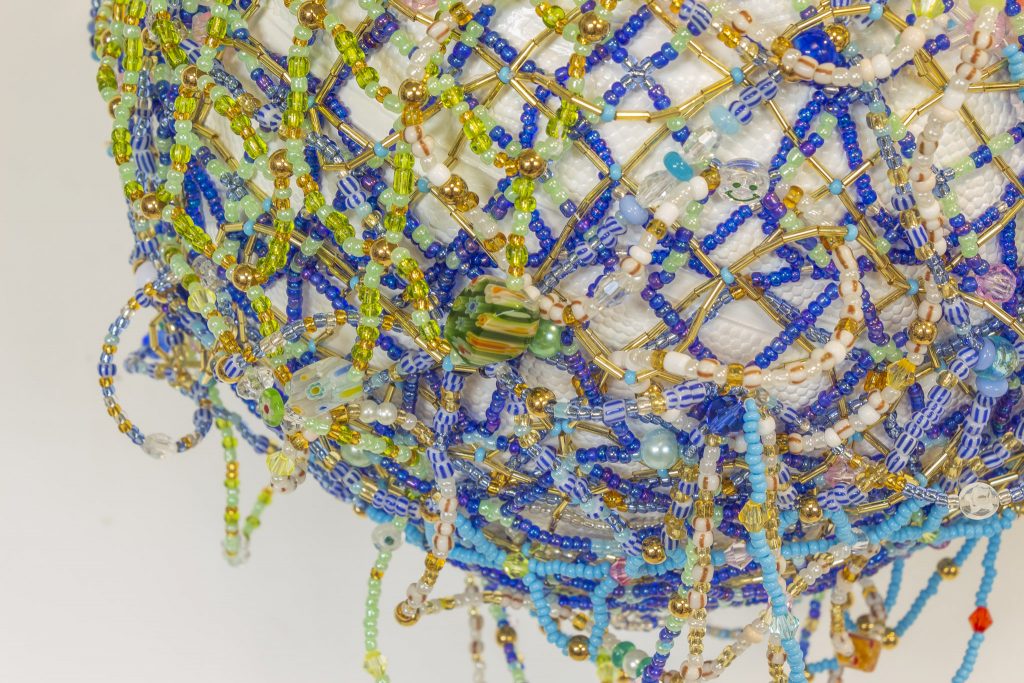The Language of Beads

Beads are among the earliest known forms of human art & communication, used for over 140,000 years to express social, political and spiritual belief. Glass beads in particular carry histories of migration, global trade, (colonial) power and ritual use. Through research, apprenticeships, an international residency, community workshops and a solo exhibition at the Nationaal Glasmuseum Leerdam, Jorge Mañes Rubio will explore glass beadwork as a multilayered communication system, challenging Eurocentric ideas of value and authenticity. The project will question the existing boundaries in creative & artistic fields, instead recontextualising glass beads as a contemporary language to articulate more diverse futures, generate micro-spaces for knowledge exchange, nourishment and world-building, one bead at a time.
Despite their significance, beads are often overlooked in design and contemporary art discourse. Through this project, we ask: Can we reconsider glass beads as tools for future storytelling? Can we move beyond viewing them as exotic relics and instead recognize their ongoing relevance? How could glass beads empower future generations of artists and makers? Can we move past ‘othering’ beadwork as ‘ ancient’, ‘exotic’ and ‘curious’ objects, and assess its creative potential? And are Western artists even ‘allowed’ to work with glass beads in these ways? Many beaded objects in European collections were removed from their original contexts and reduced to ethnographic curiosities, often serving as instruments for European narratives. With curator Maria Rey-Lamslag—whose background lies in Art History and Critical Heritage Studies—we will explore how to ethically engage with these objects and their makers, challenging colonial frameworks and advocating for a more inclusive definition of art & design.
Based in Amsterdam, Jorge Mañes Rubio’s artistic practice rethinks our relationship with the universe and all the beings that live in it, suggesting alternatives to established systems of power and representation. He takes common objects and reimagines them as powerful entities, exploring the role that materiality plays in the negotiation and production of myth, identity and place. He is co-founder of Design Museum Dharavi, a TED speaker, tutor at Design Academy Eindhoven and the recipient of the S&R Foundation Washington Award.
Maria Rey-Lamslag is a Rotterdam-based researcher and curator with a background in Art History and Critical Heritage Studies. She has experience in concepting and creating public programmes and exhibitions, centralising museum archives, historical collections and contemporary art. Maria has worked with art initiatives like NEST and MAMA Rotterdam and institutions like the Amsterdam Museum, the Wereldmuseum and the Rijksmuseum.
Mbali Mthethwa is a Johannesburg-based cultural practitioner and researcher committed to preserving and innovating African artisanal heritage. In 2019, Mthethwa founded The Herd, a multi-award-winning collaborative collective that bridges traditional Nguni artisanal techniques with contemporary design. Mthethwa’s practice seamlessly blends cultural preservation, community engagement and innovation, contributing to the evolution of the design field and highlighting the rich narratives of African heritage.
Amsterdam-based Wasjikwa Foundation, “Our House “ in Lokono djang, the language of the Arawaks, is the house for Indigenous cultural heritage from Suriname. Their work focuses on awareness of Surinamese Indigenous history and culture: together with cultural makers they work on publications and events to commemorate their ancestors and exchange lost ancestral knowledge.
